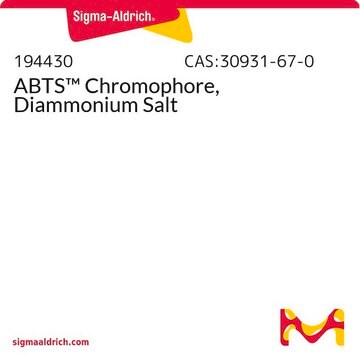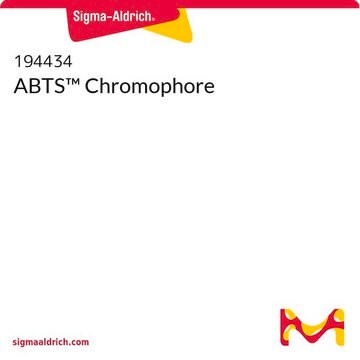11557
2,2′-azino-bis(acide 3-éthylbenzothiazoline-6-sulfonique) diammonium salt
chromogenic, ≥98% (HPLC), powder or crystals
Synonyme(s) :
2,2′-azino-bis(3-éthylbenzothiazoline-6-sulfonate) de diammonium, AzBTS-(NH4)2
About This Item
Produits recommandés
product name
2,2′-azino-bis(acide 3-éthylbenzothiazoline-6-sulfonique) diammonium salt, ≥98% (HPLC)
Pureté
≥98% (HPLC)
Forme
powder or crystals
Impuretés
≤6.0% water
Solubilité
H2O: 10 mg/mL, slightly hazy to clear
Température de stockage
2-8°C
Chaîne SMILES
[NH4+].[NH4+].CCN1C(\Sc2cc(ccc12)S([O-])(=O)=O)=N\N=C3/Sc4cc(ccc4N3CC)S([O-])(=O)=O
InChI
1S/C18H18N4O6S4.2H3N/c1-3-21-13-7-5-11(31(23,24)25)9-15(13)29-17(21)19-20-18-22(4-2)14-8-6-12(32(26,27)28)10-16(14)30-18;;/h5-10H,3-4H2,1-2H3,(H,23,24,25)(H,26,27,28);2*1H3/b19-17-,20-18-;;
Clé InChI
OHDRQQURAXLVGJ-AXMZSLBLSA-N
Vous recherchez des produits similaires ? Visite Guide de comparaison des produits
Application
- in the radical scavenging assay to test the antioxidant property of Pinus densiflora bark (PDB) extracts
- to test the antioxidant capacity (AOC) of Aloe vera samples
- as a substrate for streptavidin-horse radish peroxidase (HRPO) in enzyme-linked immunosorbent assay (ELISA)
Autres remarques
Code de la classe de stockage
11 - Combustible Solids
Classe de danger pour l'eau (WGK)
WGK 3
Point d'éclair (°F)
Not applicable
Point d'éclair (°C)
Not applicable
Équipement de protection individuelle
dust mask type N95 (US), Eyeshields, Gloves
Certificats d'analyse (COA)
Recherchez un Certificats d'analyse (COA) en saisissant le numéro de lot du produit. Les numéros de lot figurent sur l'étiquette du produit après les mots "Lot" ou "Batch".
Déjà en possession de ce produit ?
Retrouvez la documentation relative aux produits que vous avez récemment achetés dans la Bibliothèque de documents.
Les clients ont également consulté
Notre équipe de scientifiques dispose d'une expérience dans tous les secteurs de la recherche, notamment en sciences de la vie, science des matériaux, synthèse chimique, chromatographie, analyse et dans de nombreux autres domaines..
Contacter notre Service technique








